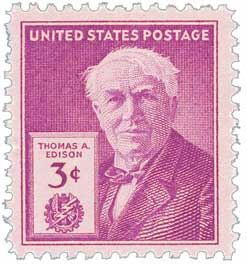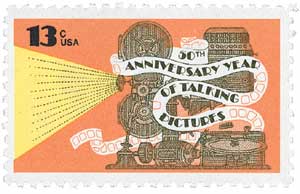
# 3064 FDC - 1996 32c Pioneers of Communication: William Dickson
US #3064
1996 William Dickson
- First Day Cover
- One of four stamps commemorating 19th century inventors
- Features inventor of early motion picture photography
Category of Stamp: Commemorative
Set: Pioneers of Communication
Value: 32¢, First-Class mail rate
First Day of Issue: February 22, 1996
First Day City: New York, New York
Printed by: Ashton-Potter (USA) Ltd.
Printing Method: Lithographed
Format: Panes of 20 (4 across, 5 down) from plates of 120 (8 across, 15 down)
Perforations: 11.1 X 11
Reason the stamp was issued: The set of four stamps pays tribute to four communication pioneers whose inventions led the way in mass communications.
About the stamp design: Fred Otnes was the artist who produced the images for these stamps. He used photos of the inventors and of the inventions or discoveries they made as inspiration for his designs. Each stamp also includes the signature of the inventor and a line describing their invention, along with birth and death dates.
First Day City: The First Day of Issue ceremony was held on the opening day of the Postage Stamp Mega-Event in New York City, New York.
About the Pioneers of Communication set: Issued as a block of four, these stamps honor the achievements of four communication pioneers. Each stamp combines a portrait of the inventor with an image of his invention: Eadweard Muybridge with a series of photographs taken by his zoopraxiscope; Ottmar Mergenthaler with a linotype machine; Frederic Ives with an enlarged halftone photogravure image; and William Dickson with motion picture images taken from his work with Thomas Edison.
History the stamp represents:

Inventor William Kennedy-Laurie Dickson was born on August 3, 1860, in Le Minihic-sur-Rance, Brittany, France. Dickson helped invent the Kinetoscope and Mutoscope, early steppingstones in the motion picture industry.
Dickson’s father was a Scottish astronomer and the family claimed to be related to painter William Hogarth. By the time he was 19, Dickson’s father had died and he, his mother, and sisters were living in Great Britain. In 1879, he wrote a letter to Thomas Edison asking for a job, but was rejected. Shortly after, he and his family moved to Virginia. Four years later, Dickson was finally hired to work at the Edison Machine Works, a producer of jumbo dynamos (large direct-current generators) on Goerck Street in New York. Later, Dickson became a lab photographer at Edison’s West Orange, New Jersey, laboratory.

In 1888, Edison wanted to build a device that would do “for the Eye what the phonograph does for the Ear.” He filed a preliminary claim with the US Patent Office and tasked Dickson with developing the idea into the Kinetoscope, the forerunner of the motion-picture film projector. Dickson worked with the Eastman company on celluloid film for the Kinetoscope. He initially developed the machine to use 19 mm film, and debuted it to the public at a meeting of the National Federation of Women’s Clubs in 1891 hosted by his wife.
Dickson worked to improve the Kinetoscope, changing it to use 35 mm film with a 1.33:1 picture ratio, which became the standard. He completed his work in the fall of 1892, and the new Kinetoscope was first shown to the public on May 9, 1893, at the Brooklyn Institute of Arts and Sciences.

Dickson’s Kinetoscope used a 50-foot strip of celluloid film which passed quickly between a lens and a light bulb. To watch, the viewer peered into a peephole. Behind the peephole was a spinning wheel with a small slit that acted as a shutter, permitting a brief glimpse of each frame of film as it passed the viewer’s eye. The result was quite lifelike.

Dickson and his team also developed the Kinetograph camera to photograph films for their experiments. He also designed and constructed the world’s first movie studio, the “Black Maria,” at the West Orange location. By 1895, Dickson was also working as an advisor to the Latham brothers Kinetoscope company. That April, he left Edison’s company to work with the Lathams and may have helped develop the Latham loop, which permitted the use of much longer filmstrips.

Dickson then helped found the American Mutoscope and Biograph Company. He helped invent the Mutoscope, a peephole-style viewer that utilized large cardboard photographs flipped by a hand crank; it outperformed the Kinetoscope. In 1892, Dickson and his wife, Antonia, published The Life and Inventions of Thomas Alva Edison. Dickson moved to Britain in 1897 to lead the company’s British team. He was the first person to make a film of the pope and his camera was blessed by Pope Leo XIII. Dickson left the company in 1911 and died on September 28, 1935.

US #3064
1996 William Dickson
- First Day Cover
- One of four stamps commemorating 19th century inventors
- Features inventor of early motion picture photography
Category of Stamp: Commemorative
Set: Pioneers of Communication
Value: 32¢, First-Class mail rate
First Day of Issue: February 22, 1996
First Day City: New York, New York
Printed by: Ashton-Potter (USA) Ltd.
Printing Method: Lithographed
Format: Panes of 20 (4 across, 5 down) from plates of 120 (8 across, 15 down)
Perforations: 11.1 X 11
Reason the stamp was issued: The set of four stamps pays tribute to four communication pioneers whose inventions led the way in mass communications.
About the stamp design: Fred Otnes was the artist who produced the images for these stamps. He used photos of the inventors and of the inventions or discoveries they made as inspiration for his designs. Each stamp also includes the signature of the inventor and a line describing their invention, along with birth and death dates.
First Day City: The First Day of Issue ceremony was held on the opening day of the Postage Stamp Mega-Event in New York City, New York.
About the Pioneers of Communication set: Issued as a block of four, these stamps honor the achievements of four communication pioneers. Each stamp combines a portrait of the inventor with an image of his invention: Eadweard Muybridge with a series of photographs taken by his zoopraxiscope; Ottmar Mergenthaler with a linotype machine; Frederic Ives with an enlarged halftone photogravure image; and William Dickson with motion picture images taken from his work with Thomas Edison.
History the stamp represents:

Inventor William Kennedy-Laurie Dickson was born on August 3, 1860, in Le Minihic-sur-Rance, Brittany, France. Dickson helped invent the Kinetoscope and Mutoscope, early steppingstones in the motion picture industry.
Dickson’s father was a Scottish astronomer and the family claimed to be related to painter William Hogarth. By the time he was 19, Dickson’s father had died and he, his mother, and sisters were living in Great Britain. In 1879, he wrote a letter to Thomas Edison asking for a job, but was rejected. Shortly after, he and his family moved to Virginia. Four years later, Dickson was finally hired to work at the Edison Machine Works, a producer of jumbo dynamos (large direct-current generators) on Goerck Street in New York. Later, Dickson became a lab photographer at Edison’s West Orange, New Jersey, laboratory.

In 1888, Edison wanted to build a device that would do “for the Eye what the phonograph does for the Ear.” He filed a preliminary claim with the US Patent Office and tasked Dickson with developing the idea into the Kinetoscope, the forerunner of the motion-picture film projector. Dickson worked with the Eastman company on celluloid film for the Kinetoscope. He initially developed the machine to use 19 mm film, and debuted it to the public at a meeting of the National Federation of Women’s Clubs in 1891 hosted by his wife.
Dickson worked to improve the Kinetoscope, changing it to use 35 mm film with a 1.33:1 picture ratio, which became the standard. He completed his work in the fall of 1892, and the new Kinetoscope was first shown to the public on May 9, 1893, at the Brooklyn Institute of Arts and Sciences.

Dickson’s Kinetoscope used a 50-foot strip of celluloid film which passed quickly between a lens and a light bulb. To watch, the viewer peered into a peephole. Behind the peephole was a spinning wheel with a small slit that acted as a shutter, permitting a brief glimpse of each frame of film as it passed the viewer’s eye. The result was quite lifelike.

Dickson and his team also developed the Kinetograph camera to photograph films for their experiments. He also designed and constructed the world’s first movie studio, the “Black Maria,” at the West Orange location. By 1895, Dickson was also working as an advisor to the Latham brothers Kinetoscope company. That April, he left Edison’s company to work with the Lathams and may have helped develop the Latham loop, which permitted the use of much longer filmstrips.

Dickson then helped found the American Mutoscope and Biograph Company. He helped invent the Mutoscope, a peephole-style viewer that utilized large cardboard photographs flipped by a hand crank; it outperformed the Kinetoscope. In 1892, Dickson and his wife, Antonia, published The Life and Inventions of Thomas Alva Edison. Dickson moved to Britain in 1897 to lead the company’s British team. He was the first person to make a film of the pope and his camera was blessed by Pope Leo XIII. Dickson left the company in 1911 and died on September 28, 1935.











